
(37K)
443 x 573
| Sunday: St. Lawrence "Outside the Walls", is one of the three "Minor" Basilicas of Rome since the time of Pope Leo I (440-461), actually made from a combination of 3 different buildings. To hold the tomb of St. Lawrence, a deacon and martyr who was "roasted" to death on a griddle.
|

(26K)
426 x 551
| Although it was the only Church in Rome to be damaged during World War II (in allied air raids), it has been meticulously restored to its 13th century state. |
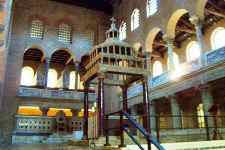
(36K)
648 x 433
| The main altar dates from the 12th century. Notice the multilevel arches and the 13th century episcopal throne in the back.
|
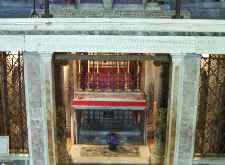
(47K)
731 x 537
| Under the main altar, as the inscription says, are the relics of St. Lawrence (d. 258), St. Stephen (the Church's first martyr: from the Acts of the Apostles) and St. Justin (d. 165). |
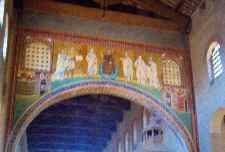
(31K)
635 x 429
| This is a 6th century mosaic of Christ and the martyrs (fuzzy).
|
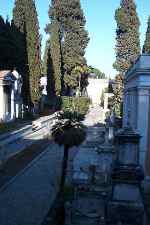
(39K)
433 x 648
| St. Lawrence sits next to Campo Verano, a massive cemetery, with many beautiful mausoleums and monuments not shown here. |
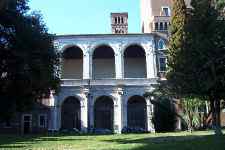
(34K)
646 x 433
| Monday: St. Marks, originally dedicated to the Evangelist, Pope St. Mark built this parish (336) over an older oratory. The massive portico with arches were constructed in 1465 by Pope Paul II
|
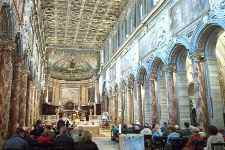
(49K)
648 x 433
| Note the columns veneered with Jasper, and the 15th century coffered ceiling (one of the oldest like it in Rome) by Dolci, architect of the Sistine chapel. |
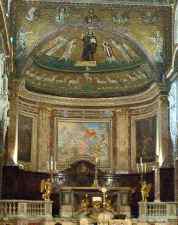
(39K)
457 x 576
| The main mosaic in the apse dates to Pope Gregory IV (827-844), showing Christ blessing surrounded by saints.
|
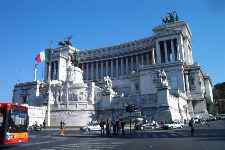
(33K)
648 x 433
| St. Marks sits on Piazza Venezia facing the Victor Emmanuel monument. St. Marks is the national church of Venecians. The relics of St. Mark have been "kept" in Venice since 829. |
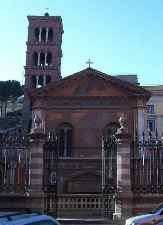
(26K)
410 x 565
| Tuesday: Santa Pudenzia, named after St. Pudenziana, a virgin who with her sister St. Prassede (Praxedes) is said to have buried the relics of martyrs killed by the emperor Nero.
|
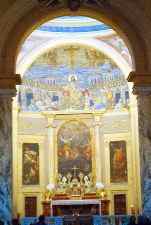
(31K)
382 x 569
| Already in the 2nd century an oratory was built here, which was rebuilt it the 4th century and modernized in the 16th. |
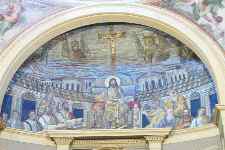
(56K)
864 x 578
| Notice the magnificent 4th century mosaic, visualizing Christ and the apostles as Roman senators. The buildings in the background are those built by Constantine in Jerusalem. The symbols of the Evangelists next to the crucifix are the oldest preserved example of such. (St. Mark is the winged-lion.) Note the two women saints are behind the apostles holding wreaths. The open book Christ holds says "Dominus conservator ecclesiae Pudentianae" - The Lord, preserver of the Pudenzian church.
|
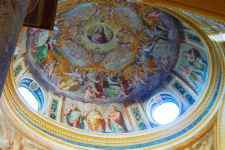
(42K)
719 x 482
| The dome over the main altar. Some say the name of the Church actually original comes from Senator Pudens, the grandfather of the two saints, and therefore this was the home that hosted St. Peter when he came to Rome. (Pudens is possibly mentioned in 2 Tim 4:21.) |
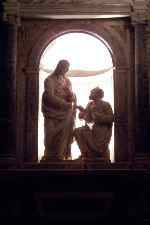
(28K)
432 x 648
| This side chapel of St. Peter, with Porta's fine relief of the conferral of the keys to Peter by Christ, also contains a slice of St. Peter's altar table (the rest of it being in the high altar at St. John Lateran).
|
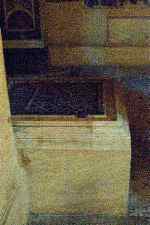
(20K)
337 x 504
| The Church encloses the well in which Sts. Pudenziana and Prassede are said to have buried the Neronian martyrs. |

(18K)
504 x 337
| It is said to contain the relics of over 3,000 early martyrs, very hard to see here (looking into the well).
|

(44K)
648 x 433
| A beautiful side chapel of the Caetani family of Boniface VIII, built in the 16th century. |
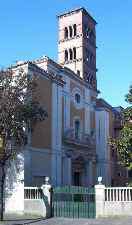
(36K)
382 x 648
| Wednesday: St. Sisto, built on the spot where Pope St. Sixtus II, on the way to his martyrdom under Emperor Valerian, met St. Lawrence in 258.
|
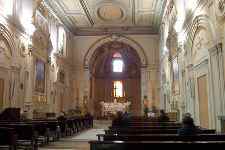
(39K)
720 x 482
| Restored numerous times in the 9th, 12th, and 15th centuries, with the current restoration dating to 1856, little probably remains of the original 6th century church. |
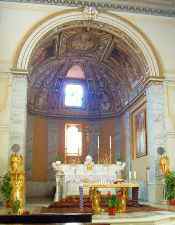
(35K)
504 x 648
| The relic of Pope St. Sixtus II (6th century) were moved here from the Catacombs of St. Callistus.
|
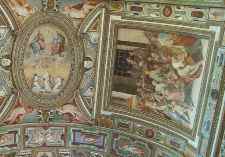
(54K)
720 x 505
| There is an interesting series of 13th century frescos with scenes from the New Testament. |
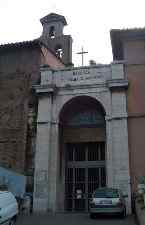
(26K)
419 x 648
| Thursday: Sts. Cosmas and Damien. Standing along the Roman Forum, it was originally a city building built by Emperor Vespian, and still has a circular vestibule opening onto the Forum constructed by Maxentius. They were transformed into a Church by Pope Felix IV (526-530).
|
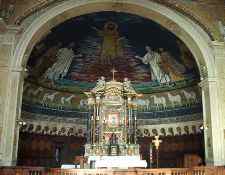
(46K)
645 x 504
| The 6th century mosaic of Pope Felix is one of the finest in Rome and frequently copied. Christ coming out of the clouds, with Sts. Peter and Paul, Cosmas and Damien standing along the Jordan River. |

(29K)
375 x 648
| Sts. Cosmas and Damien were twin brothers, known for their skill as doctors and for treating the poor without taking payment, who were martyred during the persecution of Diocletian.
|

(28K)
414 x 648
| The pleasant 17th century cloister, today is cared for by Third Order Regulars of St. Francis. |
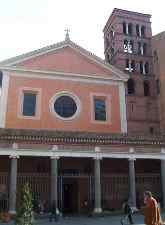
(31K)
477 x 648
| Friday: St. Lawrence "in Lucina", one of the 25 original parishes of Rome, which also recalls Lady Lucina, a generous early christian woman who built the original oratory.
|
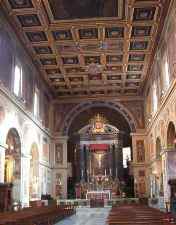
(38K)
451 x 576
| The original 4th century oratory was destroy and had to be rebuilt by Pope Paschal II (1099-1119), and modernized in the 17th century by Pope St. Pius V. Paschal's episcopal throne still remains in the choir. |
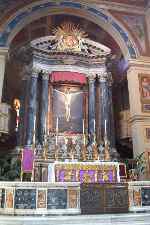
(48K)
434 x 648
| Over the main altar is Guido Reni's Crucifixion, a masterpiece of religious art.
|

(45K)
427 x 720
| The side altar of St. Lawrence, below the altar is the gridiron on which St. Lawrence is said to have been roasted. As he was burned alive, tradition says his last quip was: 'Turn me over, I'm done on this side!' - probably the reason he is patron saint of cooks. |
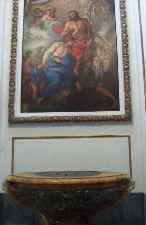
(28K)
422 x 648
| The large baptismal font, with a painting of Christ's baptism by John the Baptist in the Jordan.
|
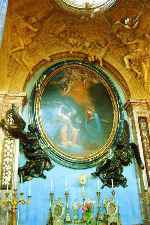
(55K)
482 x 720
| A side chapel dedicated to Our Lady designed by Bernini, although modified later, notice the fine statues and angels. |

(22K)
720 x 489
| The Church also contains a full size duplication of the Shroud of Turin. The image of Christ holy face is in the center, with his body running from left to right.
|
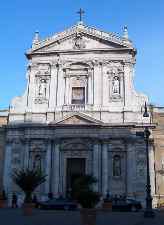
(39K)
473 x 648
| Saturday: St. Susanna, daughter of a priest St. Gabinus and niece of Pope St. Caius, was beautiful, educated and charming. Emperor Diocletian sought her to be the wife of his son-in-law, and then beheaded her (in her home, at this site in 290 along with her father) for her refusal, since she considered herself a bride of Christ. [Also note the fine example of Baroque facade, done by Maderna in 1603, before he began St. Peter's facade.] |
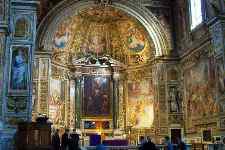
(57K)
753 x 504
| The original oratory made out of their home was enlarged in the 7th century and renovated in the 16th with vast Renaissance frescoes (depicting the Old Testament story of Susanna, a Jewish woman who was falsely charged with impurity but saved by Daniel.)
|

(31K)
404 x 648
| The crypt altar (at the ground level of the early church). The relics of Sts. Caius, Gabinus and Susanna are reserved under the main altar, with Sts. Felicity and Silenus in the crypt.
|
| St. Susanna's also commemorates an unusual saint, Genesius, the patron saint of actors. He is said to have been the leading comedian of his day, and while making fun of Christ and Christianity on stage, was suddenly and unexpectedly converted. He died for his faith under Diocletian's persecution.
|



































